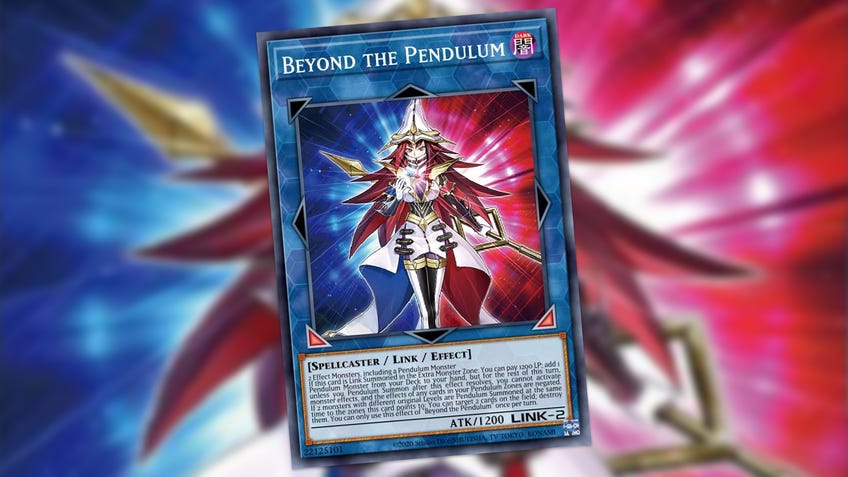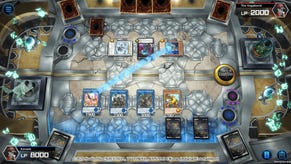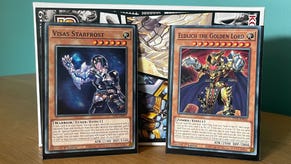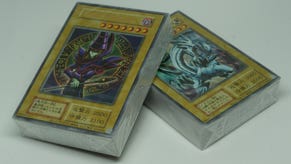How to summon in Yu-Gi-Oh!: Every summoning type explained
Looking to learn your Fusion, Ritual and Synchro Summons from your Xyz, Pendulum and Link Summons? Start here!
Whether it’s your first time discovering the heart of the cards, or you’re rediscovering Yu-Gi-Oh! as its 25th anniversary celebrations continue, learning how to summon in Yu-Gi-Oh! is essential to grasping the core mechanics of one of the world’s most popular trading card games.
What makes Yu-Gi-Oh! so unique is the breadth of summoning styles and options available to players of all playing styles - whether you like summoning legendary monsters like Blue-Eyes White Dragon or want to explore some of the newer monsters introduced over the last 25 years. In this guide, we will explain how to perform all nine summoning types available in Yu-Gi-Oh!:
How to Summon in Yu-Gi-Oh! TCG
- Normal Summon
- Tribute Summon
- Special Summon
- Fusion Summon
- Ritual Summon
- Synchro Summon
- Xyz Summon
- Pendulum Summon
- Link Summon
Comprehending the full spectrum of how to summon in Yu-Gi-Oh! will give you the edge you need to become a master duelist.
How to Normal Summon in Yu-Gi-Oh!
Normal Summoning is the most basic summoning type in Yu-Gi-Oh! It is very simple: any monster you have in your hand with a star level of 4 or lower can be played into the monster field.
Cards can be Normal Summoned either in a face-up attack position (card position portrait) or a facedown defence position (card position landscape). When you play a card facedown, the card is declared “set” rather than summoned, meaning that your monster cannot be affected by summon negation cards like Horn of Heaven. However, any facedown card cannot use its respective effects until Flip Summoned - when either the player flips the card face-up to attack position or an opponent’s monster attacks the facedown card.
Most decks in Yu-Gi-Oh! will use Normal Summoning in some capacity. However, unless altered by another card/spell effect, a player can only Normal Summon once per turn. A Normal Summon will typically be used either as the first action within a long chain of summons or, if you draw absolutely nothing of use, as a way to help defend your life points from your opponent’s attacks next turn.
How to Tribute Summon in Yu-Gi-Oh!
If you have a monster that is star level 5 or higher, you cannot play it immediately to the monster zone. (Gone are the lofty days of Seto Kaiba slapping down three Blue-Eyes White Dragon cards for funsies.) Instead, you must use monsters that are already in the monster zone as a tribute by placing them into the graveyard and replacing them with whichever monster you are looking to summon. This is known as Tribute Summoning in Yu-Gi-Oh!
For monsters that are rated a 5 or 6-star level, you can use one monster as a tribute to Tribute Summon. For monsters rated 7+ star level, you have to use two. Unlike other summoning techniques like Synchro Summoning, where you have to match the star level of the monster you want to Synchro Summon with whichever monsters you tribute, any monsters in your monster zone can be used as a tribute to summon. Two level-1 Kuriboh could in theory be tributed to summon the level-7 Dark Magician.
Within modern Yu-Gi-Oh! metas, Tribute Summoning will be extremely rare and situational. For starters, much like Normal Summoning, you can only tribute summon once per turn. On top of this, it’s an unwieldy and impractical method of getting your boss monsters on the field, as you will need at the very minimum one whole turn before you can summon anything substantial - and two if you’re looking to achieve Kaiba’s Blue-Eyes White Dragon dreams. Therefore, Tribute Summoning will only be useful in a situation where your usual summoning methods are unavailable to you.
What is Special Summoning in Yu-Gi-Oh?
Special Summon is used as a catch-all term for any Yu-Gi-Oh! summoning type that isn’t Normal. Every summoning type listed below is considered a Special Summon; even though they have their idiosyncrasies, they all share a common thread within Special Summoning. For example, there are zero restrictions to the amount of cards you can Special Summon throughout a turn, which do not affect a player's Normal Summon slot and in some rarer cases do not require tributes to summon higher-level monsters.
Special Summoning outside of the corresponding summoning types can happen through various methods. Some card effects allow for additional Special Summoning. For example, Normal Summoning White Tiger Summoner will allow you to also Special Summon one level 4 or lower Normal monster from your hand - effectively doubling the amount of summons you have made in a turn. There are even decks that are built solely around the concept of Special Summoning, such as Ultra Athletes, which can swap in and swap out with each other as Special Summons, activating various card effects when they do.
Special Summoning is the linchpin to all decks in Yu-Gi-Oh! Whichever Special Summon method you choose depends entirely on the type of deck you want to play.

How to Fusion Summon in Yu-Gi-Oh!
The idea of Fusion Summoning in Yu-Gi-Oh! is that you are blending two corresponding monsters to form a new, more powerful variant. These Fusion Monsters (always printed within a purple card design) do not appear in your main deck, instead occupying the Extra Deck so a player doesn’t need to have the Fusion monster in hand.
As long as you have the material monsters stated on the Fusion monster in your hand or on the monster field and the spell card Polymerization, you can tribute the monsters you need to Fusion Summon the more powerful one. For example, to summon Dark Paladin you will need to fuse Dark Magician with Buster Blade. For Blue-Eyes Ultimate Dragon, use Polymerization on three Blue-Eyes White Dragons.
This is the most common way a player will Fusion Summon, but by far not the only method. Some monsters, such as D/D Swirl Slime, can perform the function of a Polymerization spell card. There are even variants of the Polymerization spell card itself, such as Super Polymerization which allows a player to use an opponent’s monster as a Fusion material.
Fusion Summoning offers players a simple-to-grasp method of summoning powerful monsters; as Yu-Gi-Oh! evolves to rely less on vanilla Polymerization to achieve Fusion, it has cemented itself as a compelling option for players.
How to Ritual Summon in Yu-Gi-Oh!
Ritual Summoning in Yu-Gi-Oh! shares a lot of parallels with Fusion Summoning, in that monsters from your hand or monster zone will be tributed to summon a more powerful monster using a spell card.
In the case of Ritual Summoning, rather than the targeted monster being in your Extra Deck, you will need the Ritual Monster (always printed in a light blue card design) in your hand to be able to summon it. On top of that, each Ritual spell is unique to the Ritual monster you are looking to summon - unlike Fusion Summoning’s Polymerization, which is a catch-all spell card. For example, to summon Black Luster Soldier, you need to have Black Luster Soldier in your hand, the Ritual spell card Black Luster Ritual and monsters in your hand or monster zone to tribute.
The good news is that, unlike Fusion Summoning where you need very specific monsters to achieve the goal, as long as you meet the level requirement with your tributes you can use any monsters as a tribute in Ritual Summoning.
However, the need to have a specific Ritual spell card alongside the Ritual monster itself in your main deck instead of the Extra Deck does mean that Ritual Summoning takes up a significant amount of space within a deck. Therefore, the strategies used to make Ritual Summoning decks competitive can be more complex, with many cards included within the deck looking to fetch specific cards to achieve the Ritual Summon as fast as possible. Lots of fun, but requires a little more attention.

How to Synchro Summon in Yu-Gi-Oh!
For those players who enjoyed the original anime series all those years ago, who might be returning to Yu-Gi-Oh! for the first time in a long time, Synchro Summoning might be new for you. Synchro monsters (always printed in a white card design), much like Fusion monsters, live within your Extra Deck.
To summon monsters using Synchro Summoning, you have to have the tribute materials on the monster field - and at least one of those materials has to be labelled as a “Tuner” monster in the monster description. From there, you need to exactly match the total monster levels tributed to the level of the Synchro monster you’re looking to summon. Then, you can Synchro Summon!
Unlike Fusion and Ritual Summoning, Synchro Summoning doesn’t rely on a spell effect for the summon to occur. As long as you have the right materials on the field of play and the Tuner monster, you can summon freely. This makes Synchro Summoning extremely simple to achieve, as various monsters within Synchro decks can perform the Tuner function, so the likelihood of drawing one is significant. On top of this, many Synchro monsters are some of the most powerful in the game, such as Baronne de Fleur.
There are some restrictions to Synchro Summoning. For example, you will need to have the monsters you want to tribute on the field of play, rather than being in your hand as with Fusion and Ritual Summoning. You will also need to make sure you match exactly the star level of the monster you’re looking to summon with the monsters being tributed. But these conditions are easy to meet with a well-built deck and will unlock some of the most powerful monsters Yu-Gi-Oh! has to offer.
How to Xyz Summon in Yu-Gi-Oh!
In most Special Summons in Yu-Gi-Oh!, the cards used as tributes find their way to the graveyard upon being used as materials. However, with Xyz Summoning (pronounced “ex-zeez”), those tributed monsters' functions don’t end once the new card materialises. Instead, they become materials attached to the Xyz monster (always printed in a black card design).
In-game, you will stack the Xyz monster on top of the cards tributed and, more often than not, can then use the materials to trigger certain card effects from the summoned monster. For example, with Number 41: Bagooska the Terribly Tired Tapir, detaching one of the materials used to summon the card will allow you to protect the Tapir from card effects for the rest of the turn.
What makes Xyz Summoning so unique in comparison to other Special Summoned monsters is that, by and large, a card’s effect is only limited to how many materials are attached to the card, unlike most card effects that can only happen once per turn. Cards like the devastating Divine Arsenal AA-ZEUS - Sky Thunder, which can wipe the field in exchange for two attached materials, can keep doing this provided the materials are there to be used.
Xyz Summoning can be an incredibly strong deck engine for new players and existing players alike to get the upper hand on their opponent. Understanding how to summon Xyz monsters in Yu-Gi-Oh! effectively will be beneficial regardless of the stratagems you decide to use.

How to Pendulum Summon in Yu-Gi-Oh!
Pendulum Summoning is unlike any other Special Summon and represents the most complicated summon type in Yu-Gi-Oh! Pendulum Summons can only be performed by Pendulum monsters, which are cards with a teal blue text box.
To play a Pendulum monster, you have to place it not in the monster zone, but within a Pendulum zone. These are located on the far left and right of the spell/trap zone, behind where your monsters are played. Pendulum monsters have a scale number associated with them. You need to make sure the two Pendulum Monsters in your Pendulum zones have different scale numbers (for example, one could be 3 and the other 10). When you activate the Pendulum scale, you will be allowed to summon as many monsters in your hand between the Pendulum monsters’ scale levels as you possess - in our example, between the star levels of 3 and 10.
This baseline strategy offers a simple and effective way to summon lots of monsters to the field. If you’re playing a deck like Deskbots, this is all you will need to do. However, the most viable Pendulum decks in Yu-Gi-Oh!, such as D/D/D, will often use the Pendulum monsters not for their Pendulum scale capabilities, but for the effects they can use while in the Pendulum zone. They will be then subsequently destroyed, typically by other card effects, and sent not to the graveyard but instead placed face-up on the Extra Deck. In reality, you will use these effects to further enhance other Special Summoning techniques like Fusion and Synchro, rather than as a catalyst to further Pendulum Summoning.
Overall, Pendulum Summoning in Yu-Gi-Oh! has the steepest learning curve of any summoning mechanic within the game. However, if you can master the intricacies of these various techniques, you will be set up to completely bamboozle your opponents with terrifying skills.
How to Link Summon in Yu-Gi-Oh!
Link Summoning is the most recent summoning type added to Yu-Gi-Oh!, and once again offers up some incredibly unique strategies to players.
Link monsters are unique in that they do not have levels in the same ways that other monsters do, so Link Summoning them doesn’t always mean you have to match or exceed the star level of the desired monster with your tributes. For example, while you need to have a level 1 monster in play to Link Summon Linkurioh, a monster like Encode Talker instead needs two or more Cyberse monsters of any level. To add to this, a Link monster’s Link level can substitute for monsters in play when Link Summoning higher-level monsters. So Encode Talker, at Link-level 3, can be used as three out of four tributes when Link Summoning Underworld Goddess of the Closed World.
Link Summoned monsters represent some of the fundamental combos of high-level Yu-Gi-Oh! play, especially in Master Duel. Many strategies will include having an I:P Masquerena in play so that on your opponent's turn you can subsequently Link Summon Knightmare Unicorn and simply remove one of their cards, for example.
Mastering Link Summoning in Yu-Gi-Oh! is often the secret win condition to many of the very best Yu-Gi-Oh! decks regardless of the principle summoning mechanic, as deadly combos are possible without having to worry too much about specific cards or card levels.










